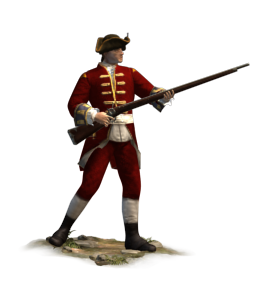Difference between revisions of "Guards (ETW Unit)"
Tango12345 (talk | contribs) (Reverting: too much of an opinion) |
(→Game Description) |
||
| Line 1: | Line 1: | ||
{{Unit|image=[[Image:Guard.jpg]]|Class=Elite Infantry|Men=160|Guns=N/A|Recruitable From=Army Staff College|Region=Worldwide|Recruitment Cost=1200|Upkeep Cost=300|Technology Needed=None}} | {{Unit|image=[[Image:Guard.jpg]]|Class=Elite Infantry|Men=160|Guns=N/A|Recruitable From=Army Staff College|Region=Worldwide|Recruitment Cost=1200|Upkeep Cost=300|Technology Needed=None}} | ||
| − | == | + | ==Overview== |
These troops are equipped in much the same way as line infantrymen, and carry smoothbore muskets as their primary weapons. There, however, the similarities end. Their uniforms are altogether more splendid, marking them out as a superior force, in arrogance if nothing else. This attitude can serve them well in battle, as the guard can hardly be seen to be cutting and running, no matter how hot the enemy fire. They are also expected to do a good job as garrison troops, keeping the royal family safe no matter what the locals might think or be tempted to do by some foolish revolutionary fervour. | These troops are equipped in much the same way as line infantrymen, and carry smoothbore muskets as their primary weapons. There, however, the similarities end. Their uniforms are altogether more splendid, marking them out as a superior force, in arrogance if nothing else. This attitude can serve them well in battle, as the guard can hardly be seen to be cutting and running, no matter how hot the enemy fire. They are also expected to do a good job as garrison troops, keeping the royal family safe no matter what the locals might think or be tempted to do by some foolish revolutionary fervour. | ||
Revision as of 09:09, 21 February 2012
Overview
These troops are equipped in much the same way as line infantrymen, and carry smoothbore muskets as their primary weapons. There, however, the similarities end. Their uniforms are altogether more splendid, marking them out as a superior force, in arrogance if nothing else. This attitude can serve them well in battle, as the guard can hardly be seen to be cutting and running, no matter how hot the enemy fire. They are also expected to do a good job as garrison troops, keeping the royal family safe no matter what the locals might think or be tempted to do by some foolish revolutionary fervour.
Historically, the French Maison du Roi (literally “house of the king”) were the epitome of household troops. They provided a ceremonial guard at every state occasion, and Louis XIV picked them from candidates sent in by each regiment; inappropriate candidates brought punishment on the officers who had sent them! The Prussian “Potsdam Giants” were a quirky household guard, the product of Frederick I’s obsession with very, very tall men and military pomp. Oddly, he wasn’t a very warlike chap at all.
Overview
Guards represent the very best most nations have to offer in terms of line infantry. They have very high morale, are resistant to morale shocks (such as being charged by cavalry) and can rally routing troops around them. Therefore, they are very reliable and should be used in key positions on the battlefield.
To prevent overuse, each faction is limited to six units of guards.
